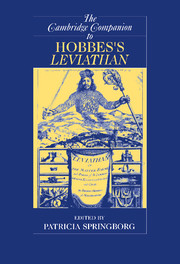Book contents
- Frontmatter
- General Introduction
- Part I: Of Man
- 1 Thomas Hobbes’s Visual Strategies
- 2 Leviathan, the Beast of Myth: Medusa, Dionysos, and the Riddle of Hobbes’s Sovereign Monster
- 3 Sense and Nonsense about Sense: Hobbes and the Aristotelians on Sense Perception and Imagination
- 4 Hobbes on the Natural Condition of Mankind
- 5 Hobbes’s Moral Philosophy
- Part II: Of Commonwealth
- Part III: Of a Christian Commonwealth
- Part IV: Of the Kingdom of Darkness
- Part V: Hobbes’s Reception
- Bibliography
- Index
- Series List
2 - Leviathan, the Beast of Myth: Medusa, Dionysos, and the Riddle of Hobbes’s Sovereign Monster
from Part I: - Of Man
Published online by Cambridge University Press: 28 November 2007
- Frontmatter
- General Introduction
- Part I: Of Man
- 1 Thomas Hobbes’s Visual Strategies
- 2 Leviathan, the Beast of Myth: Medusa, Dionysos, and the Riddle of Hobbes’s Sovereign Monster
- 3 Sense and Nonsense about Sense: Hobbes and the Aristotelians on Sense Perception and Imagination
- 4 Hobbes on the Natural Condition of Mankind
- 5 Hobbes’s Moral Philosophy
- Part II: Of Commonwealth
- Part III: Of a Christian Commonwealth
- Part IV: Of the Kingdom of Darkness
- Part V: Hobbes’s Reception
- Bibliography
- Index
- Series List
Summary
There is something strange about Hobbes's Leviathan, something vague and indefinite and contradictory. For in Leviathan, Hobbes only mentions his title monster three times. Yet these three passages actually give us very divergent images of that enigmatic political beast. We will see that the indefinite character of this monster is revealing, and that the mythological image is thus not merely a superfluous, accidental ornament but serves a theoretical purpose in Hobbes's argument. Moreover, we will see that his use of the image, which contradicts his own principles regarding method in philosophy, is in a sense a theoretical and political necessity for him.
The tensions in Hobbes's statements about Leviathan are apparent. Thus in the introduction, Hobbes professes that 'by art is created that great leviathan called a commonwealth, or state (in Latin civitas), which is but an artificial man; though of greater stature and strength than the natural, for whose protection and defence it was intended'. Here Leviathan is the state in its entirety, the organisation created by prehistoric individuals covenanting to obey the new authority. Originally, Leviathan was, of course, a huge beast, a crocodile, a whale, a fish, a snake, or a dragon. But just like the famous frontispiece of the book, Hobbes stresses that this new beast is also a ‘Man’, a person. So Leviathan is a man and an animal at the same time. However, another interesting quality is ascribed to this curious monster. It is ‘Artificiall’: it is, as we will see, a machine.
- Type
- Chapter
- Information
- The Cambridge Companion to Hobbes's Leviathan , pp. 61 - 81Publisher: Cambridge University PressPrint publication year: 2007
- 10
- Cited by



